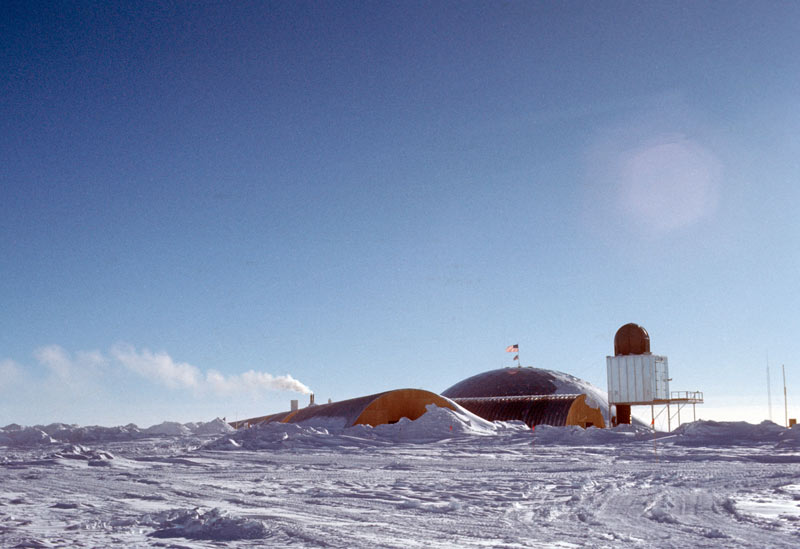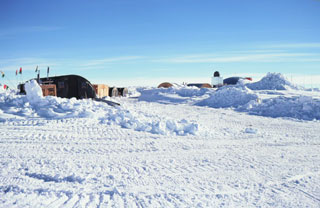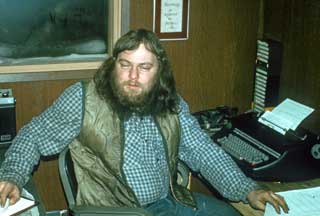Here we are...
|
Well, here we are! Scott said something not too different that began with "Great God..." (perhaps with expletives) when he arrived and stumbled upon Amundsen's tent. This is an early season look at the station while walking back from GCA...Less than 24 hours after we arrived to open the station we had not one but TWO fires in the construction camp, including the second largest fire in the history of the US Antarctic program to the present day...not exactly a morale builder for this newly arrived (and as yet unacclimated to the altitude) station manager and the rest of the crew. 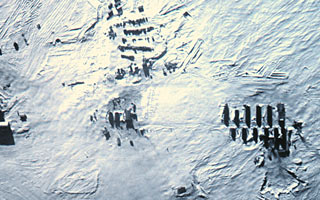
This is the best view of the construction camp I've found...None of us got a ground-level picture of the place before the fire or during the fire...too bad, those acetylene bottles shooting into the air were rather spectacular. This view is extracted from the NOAA aerial view taken late in the 1973-74 season; by the time we saw the place it was considerably more drifted in than you see here. The head/galley complex that burned is the triple-H structure you see at the lower right; the Last Chance Saloon is across the street. The power plant is in the small module at the right end of the street. In this view the dome is directly to your left (check out that NOAA view for the full picture). |
|
When I took the above 3 photos I of course had no idea that the technology would someday exist to turn them into a panorama. I've had help stitching this together more than once, more recently by Seth White, but this 2017 effort is mine...sorry that the colors don't match. Anyway, this shows the construction camp as we saw it shortly after the fire. On the left are two shop Jamesways and the garage (on the far left of aerial view above); here we were cleaning the junk (!) out of the Jamesways to make way for berthing. The garage would get turned into the emergency power plant. To the right of the garage is the new galley/head Jamesway which the construction crew was working on. Further to the right down the power line (note that this place was wired with overhead electrical service!!) is the main part of the construction camp where the berthing Jamesways and the burned-out head/galley complex were. The original summer camp power plant was located there also--the generators were unaffected by the fire and the on-line engine kept running, In the center background of the right hand photo is the emergency cache of drummed DFA which we later dug up and moved ...along with the emergency DFA bladder. At left, this photo was taken a few weeks later, we're looking toward the dome from the other side of the Jamesways and garage/power plant seen in the above panorama. In the left foreground is a new galley/head Jamesway that Pat Haggerty and the construction crew created on short notice. To the left of the new Jamesway is the emergency snow melter. A bit later, a second long berthing Jamesway would be built in front of the head/galley. (This 1976-77 photo, from the Antarctica NZ Digital Asset Manager, was taken by Ian Paterson. I have leveled it and removed a few bits of dust. See the original photo presentation for its copyright and usage restrictions.)
When we arrived we were greeted by Dan Morton, the 1976 w/o manager seen here in the "corner office." Dan was the admin coordinator in the Chalet in the 1975-76 summer; he was picked to manage Pole at the end of that summer as a replacement for the original guy. Dan did well despite stormy spring weather that required lots of skiway rework, he was glad to see us and we were glad to see him! 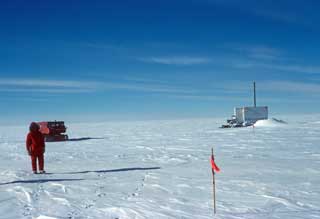 Here's Brad Halter; we went out to survey the Zoller hut--this University of Maryland project, first operated during 1973-74, had later been moved to the new station clean air sector. It was not to be operated during our year. 
A closeup of the Zoller sled. This project was operated during 1977-78 and had a winterover that year. The new clean air facility included extensive air sampling equipment, and some of the equipment was moved from this sled-mounted module to CAF a year or two later. The module was being used for other things in the 1980's--in 1984-85 it was used by a French project sponsored by Marty Pomerantz, the first submillimeter telescope, using liquid helium, at Pomerantz Land. And more recently since 2005 it has been the skua shack...(more info). 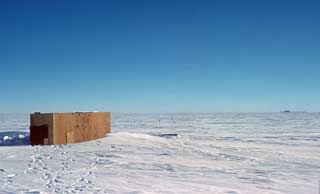
Looking back towards the distant dome from the Zoller site. The building (one of many crates left over from station construction) was probably used for generators and fuel storage. |
